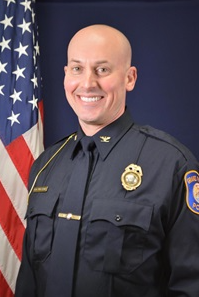
Grand Rapids Police Department
Chief Eric Winstrom has overseen the implementation of drones by Grand Rapids police.By LIZ NASS
Capital News Service
LANSING – As surveillance technology expands across Michigan, law enforcement agencies want to expand their strategies with it, finding new ways to conduct remote, efficient policing with drones.
The State Police was the first department in the nation to use drones for policing in 2015. Since then, 1,400 law enforcement agencies nationwide have implemented their use regularly.
However, issues of privacy and ethics in its use are still up in the air as drone use is relatively new, according to professor J. Richard Broughton, a criminal law expert at University of Detroit Mercy Law School.
Broughton said the biggest debate in drone surveillance is the Fourth Amendment, which protects people from unlawful search and seizure.
Broughton said other criticisms could relate to trespassing on private property by flying over it.
One of the first major court cases examining privacy inquiries with drones arose in Michigan.
In that case, which is in front of the Michigan Supreme Court, Todd Maxon claims that Long Lake Township in Grand Traverse County took photos of his 5-acre property without a warrant to use as evidence against him in a zoning dispute.
Broughton said the lawsuit is a civil case but could set a precedent on what is constitutionally acceptable when using drones in criminal cases as well.
Bob Stevenson, the executive director of the Michigan Association of Chiefs of Police, said there has been a lot of misinformation about the use of drones in general, creating more fear in communities rather than seeing the fears in courtrooms.
Stevenson said as with other police tools, people worry about what may happen to their rights when implemented.
He said the solution lies in educating the public on drone use.
“If they need to have some safeguards built in, we don’t have any objection to that,” Stevenson said. “But we do object to throwing the baby out with the bathwater.”
Jay Stanley, a senior policy analyst with the American Civil Liberties Union Speech, Privacy, and Technology Project in New York City, said a lot of the fear across the nation is that drones might be deployed in intrusive ways.
“People are forced to live their lives knowing that there may be law enforcement in the sky watching them at any time when they’re outdoors,” Stanley said. “I think that that’s probably not how most Americans want to live.”
Stanley said there have to be limitations and protections in how drones are used, such as regulations on how powerful the cameras can be and how often and where the drones are flown.
Stanley also said there should be transparency about the performance of drones. Community members “who agree to spend public money on a drone program” should be able to know if “they are getting a good bang for their buck.”
The Grand Rapids Police Department recently implemented drones, purchasing eight for $100,000 in August and holding town halls across the city throughout the summer to discuss their use.
Chief Eric Winstrom said he heard an overwhelming amount of support for the drones at the town halls and encouraging the department to catch up with smaller departments that had used the technology for years.
“The nice thing is we’re not a pilot program for this,” Winstrom said. “There are dozens, if not hundreds, of jurisdictions across the state that already have it. Of course, these are also across the country, and what we haven’t seen are complaints of violations of the Fourth Amendment.”
However, Winstrom did hear concerns from the public.
Winstrom said concerns included technology attached to drones such as facial recognition software on the cameras as well as operating them with artificial intelligence, or AI, rather than people.
He said facial recognition is not scientifically accurate and some city residents view it as an invasion of privacy.
The concerns about AI operations include possible disparate impacts of overpolicing in minority neighborhoods.
Winstrom said that’s why the Grand Rapids department doesn’t use AI operations and facial recognition software.
The ACLU’s Stanley said it is possible that drones’ video footage could still be run through AI and facial recognition after the fact.
Winstrom said drone use could also be focused on documenting crime scenes, searching for missing persons and locating criminals.
Winstrom described a recent situation where officers were documenting a homicide scene that usually require a lot of setup time for pictures. Using drones cut the time in half.
Winstrom said drones can keep an eye on large crowds for public safety purposes.
However, Stanley said if this type of surveillance includes protests, it could have a “chilling effect” on First Amendment rights because police could monitor demonstrators, even peaceful ones.
Broughton predicted the drone debate will only expand from here.
“This is entirely new territory, constitutionally speaking,” Broughton said. “There are a lot of open questions, and I think courts over the next decade are going to be grappling with a lot of issues.”

University of Detroit Mercy
Professor J. Richard Broughton is a privacy law expert at the University of Detroit Mercy.